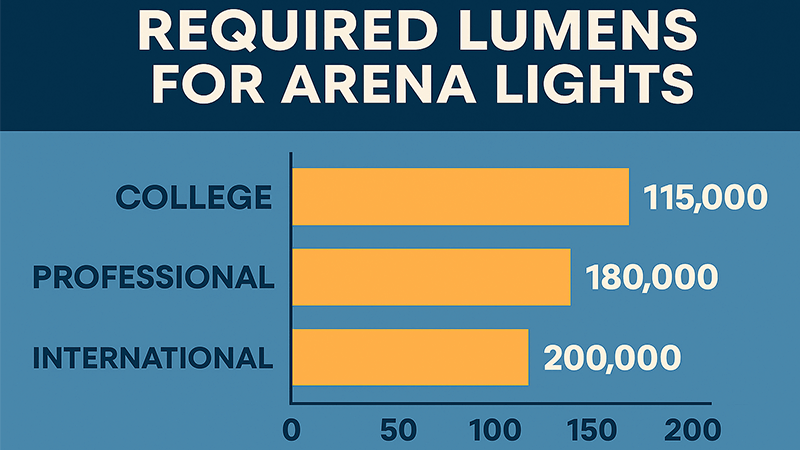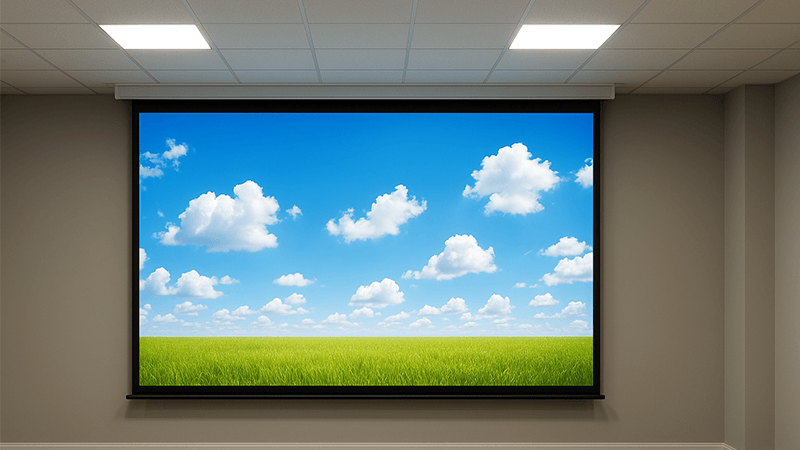Choosing the wrong arena lights leads to uneven brightness, creating a poor experience for everyone. This frustration can be avoided by understanding that more than just lumens matter for great lighting.
The required lumens for an arena depend on its size, purpose, and competition level, with fixtures often ranging from 30,000 to over 150,000 lumens. The key isn’t just total lumens, but achieving specific brightness levels (lux or foot-candles) and uniformity across the entire playing surface.

I’ve been in the lighting business for a long time, starting on the factory floor. I’ve seen countless projects succeed or fail based on the initial lighting plan. It’s easy to get focused on a single number, like lumens, and think it’s the most important factor. But in my experience, the best results come from looking at the bigger picture. A bright light is useless if it’s not in the right place or pointed in the right direction. Let’s dig deeper into what really makes arena lighting work, so you can make the best purchasing decision for your project.
Is 800 lumen brighter than 450 lumen?
Comparing lumen numbers seems straightforward and simple. But relying on this one metric alone can be very misleading when planning a large-scale project. Let’s look at what lumens really measure.
Yes, a light source rated at 800 lumens is brighter than one rated at 450 lumens. Lumens are a direct measurement of the total amount of visible light emitted by a source. So, a higher lumen number always means more total light output.

Lumen is the most basic way we measure light output. Think of it like the total volume of water flowing from a garden hose. A hose that puts out 8 gallons per minute is delivering more water than one that puts out 4.5 gallons per minute. It’s that simple. When you see a label that says 800 lumens, it is telling you the total light energy shooting out of that bulb in all directions. So, a comparison between 800 and 450 lumens is a direct one; 800 is certainly more.
However, this number becomes almost irrelevant when we talk about a massive space like an arena. An 800-lumen bulb is fine for a desk lamp, but it wouldn’t even make a dent in lighting a basketball court. For arenas, we use high-power LED fixtures that start around 30,000 lumens and can go well over 150,000 lumens each. The number of fixtures and their individual lumen rating depends entirely on the arena’s specific needs. Context is everything.
Here’s a simple table to put things in perspective:
| Light Source |
Typical Lumen Output |
Common Use |
| Candle |
~12 lumens |
Ambiance |
| 60W Incandescent Bulb |
~800 lumens |
Household Room |
| Car Headlight (High Beam) |
~1,200 lumens |
Road Illumination |
| Sports Arena Fixture |
50,000 – 150,000+ |
Professional Venue |
This shows why a simple "is X brighter than Y" question is only the start. For a purchasing manager like Shaz, the real question isn’t about small numbers but about the massive output needed for an arena and, more importantly, how that light is controlled and distributed.
Is 9000 lumens too bright?
You see a product with a high lumen count like 9000 and think it must be better. But excessive brightness creates uncomfortable glare and wastes a lot of energy. True quality comes from context.
Whether 9000 lumens is too bright depends entirely on the application. For a small workshop or a high-ceiling garage, it might be perfect. For a desk lamp, it’s dangerously bright. For an entire sports arena, it is completely inadequate.

Brightness is relative. I remember a client who wanted to light a small warehouse. He was convinced that buying the fixtures with the highest possible lumen rating was the best strategy. He bought lights that were more appropriate for a parking lot. The result? His workers complained constantly about the blinding glare. It was so bright it was actually hard to see, and his electricity bill was huge. He spent more money to create a worse working environment. We eventually replaced them with lower-lumen fixtures that had better optics designed to spread the light evenly on the shelves and floor. The space was safer, more comfortable, and he saved on energy costs.
This story shows that "too bright" is about context. For a large area like a sports arena, a single 9000-lumen source is almost nothing. You need dozens, sometimes hundreds, of much more powerful fixtures. The key is not just the total lumens, but the illuminance, which we measure in lux or foot-candles. This tells us how much light is actually landing on the surface.
Here are the lighting level requirements for different sports:
| Sport / Activity Level |
Recommended Illuminance (Lux) |
What This Means |
| Recreational Tennis |
200 – 300 lux |
Good visibility for casual play |
| Professional Basketball |
800 – 1500 lux |
Excellent clarity for fast-moving action |
| HDTV Broadcasting |
1500 – 2500+ lux |
Camera-ready, eliminates shadows for broadcast |
To achieve 1500 lux over a professional basketball court, you need millions of total lumens. This is distributed across many high-power fixtures, each one carefully aimed. So, is 9000 lumens too bright? For an arena, the answer is a definite no. It’s not nearly enough.
What are the best lights for indoor arenas?
Finding the right lights can feel overwhelming with so many options. Choosing incorrectly leads to high maintenance costs and poor performance. The best choice balances quality, efficiency, and control.
The best lights for indoor arenas are high-power LED fixtures. They offer superior energy efficiency, long lifespan, and advanced control options like dimming and directional optics. These features are critical for meeting professional standards for brightness, uniformity, and flicker-free performance for broadcasting.

In my years in the industry, the shift from metal halide to LED has been the biggest game-changer. I recall working with a client to retrofit an old community ice rink. They were spending a fortune on electricity and were constantly replacing the old, buzzing metal halide bulbs. The light was yellow and uneven, with dark corners on the ice. When we installed new LED fixtures, the transformation was incredible. The light was clean, crisp, and perfectly even. Their energy consumption dropped by over 60%, and they haven’t had to replace a single fixture in years. The instant on/off capability also means they don’t have to wait 20 minutes for the lights to warm up anymore.
That experience perfectly illustrates why LED is the only real choice today. The key benefits are undeniable. First, their energy efficiency is unmatched, leading to significant cost savings. Second, their lifespan is often over 50,000 hours, which dramatically reduces maintenance. For a high-ceiling arena, just replacing a bulb is a major operation, so this is a huge benefit.
Beyond that, the quality of LED light is superior.
- Optics: LEDs can be paired with precision lenses (optics) that direct light exactly where it is needed—on the playing surface—and not into the spectators’ eyes. This is crucial for reducing glare and achieving high uniformity.
- CRI: They have a high Color Rendering Index (CRI), meaning colors look natural and vibrant, which is important for both players and fans.
- Controls: LEDs can be integrated with smart controls. This allows for instant dimming for different events, zoned lighting, and even special effects.
When a purchasing manager asks me for the "best" light, I always say it’s the LED fixture that is backed by a professional lighting simulation, like a DIALux report. This report proves that the chosen lights and layout will meet the project’s specific requirements, especially uniformity. It takes the guesswork out of the equation.
Is 9500 lumens good for a projector?
You see "projector" and "lumens" and might think it’s all the same. But using the wrong tool for the job leads to poor results. Let’s clarify the difference between projection and general illumination.
For a projector, 9500 lumens is very powerful and suitable for large venues like auditoriums, conference halls, or places with significant ambient light. However, projector lumens are not comparable to arena lighting lumens, as they serve entirely different purposes.

It’s important to understand that a projector’s job is to create a focused image on a screen, while an arena light’s job is to flood a vast, three-dimensional space with usable light. I once had a project manager ask if they could use powerful projectors to light a small event space instead of regular lights. I explained that it wouldn’t work. A projector’s 9500 lumens are concentrated into a very specific beam to create a high-contrast image. If you aimed it at the floor, you’d get a bright rectangle, but the rest of the room would be dark. It’s designed for image clarity, not for general illumination.
Arena lighting is the opposite. A 100,000-lumen arena fixture is designed with optics that spread light over a wide area—the entire court or field. The goal is to create a consistent and uniform level of brightness so that players and spectators can see everything clearly from any angle.
The most critical factor I emphasize with clients like Shaz is light uniformity. My insight has always been that a poorly designed lighting layout, even with very bright lamps, will ruin a venue. You get distracting hotspots and dangerous dark zones. This is why we insist on providing a DIALux report. This professional simulation shows exactly how the light will be distributed. It calculates uniformity indexes like U1 and U2. For most sports, you need a uniformity rating (U2) of >0.7, which means the dimmest spot is at least 70% as bright as the average spot. You can’t achieve this by just hanging bright lights; it requires a scientific layout and the correct optical distribution for each fixture. This is how you ensure quality you can see.
Conclusion
The right lumen count is just the start. Achieving professional, high-quality arena lighting depends on a complete plan that prioritizes light distribution and uniformity to create a truly exceptional experience.